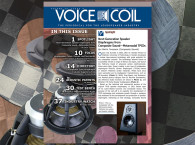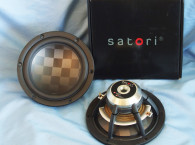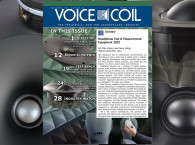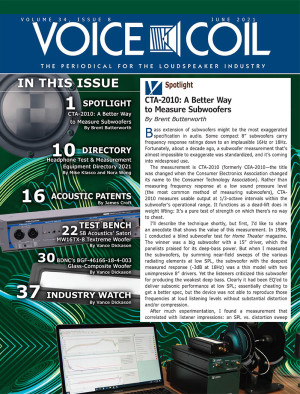 This rich edition of Voice Coil opens with a Spotlight article on the Standard Method of Measurement for Subwoofers (ANSI/CTA-2010-B R-2020). In "CTA-2010: A Better Way to Measure Subwoofers," Brent Butterworth discusses how this might be a better method for avoiding the confusion on measuring bass extension of subwoofers "the most exaggerated specification in audio," in his opinion. The article explains and demonstrates how CTA-2010 measures usable output at 1/3-octave intervals within the subwoofer’s operational range, instead of measuring frequency response at a low sound pressure level (the most common method of measuring subwoofers). "It functions as a dead-lift does in weight lifting: It’s a pure test of strength on which there’s no way to cheat," Butterworth states.
This rich edition of Voice Coil opens with a Spotlight article on the Standard Method of Measurement for Subwoofers (ANSI/CTA-2010-B R-2020). In "CTA-2010: A Better Way to Measure Subwoofers," Brent Butterworth discusses how this might be a better method for avoiding the confusion on measuring bass extension of subwoofers "the most exaggerated specification in audio," in his opinion. The article explains and demonstrates how CTA-2010 measures usable output at 1/3-octave intervals within the subwoofer’s operational range, instead of measuring frequency response at a low sound pressure level (the most common method of measuring subwoofers). "It functions as a dead-lift does in weight lifting: It’s a pure test of strength on which there’s no way to cheat," Butterworth states.
As scheduled for this edition of Voice Coil, Mike Klasco and Nora Wong (Menlo Scientific) have compiled a directory of Headphone Test & Measurement Equipment suppliers and solutions. This 2021 directory focuses on headphone measurement equipment, both analyzers and test fixtures, with profiles on some of the vendors in the industry.
For this month's Acoustic Patents column, James Croft (Croft Acoustical) explores an existing (US9693148 - 2017) patent of an "Acoustic Hailing Device," that lists Hernan Lopez (San Diego, CA) as the inventor, on behalf of LRAD Corp. The patent abstract details an acoustic hailing device featuring a pair of adjacent compression drivers, on which both feature two diaphragms, with the combination coupled to a waveguide housing. In this design, a pair of coupled driver covers forms an extension of the waveguide associated with each of the compression drivers. As usual, James Croft goes through all existing prior art inventions, and related patents, positioning the present patent in the context of today's speaker design trends and requirements. In his extended review, Croft explains why this LRAD patent appears to be more of a combination, or systems patent, of the well-established dual-diaphragm compression driver designs with very specific accomplishments.
The first in this edition's Test Bench sees Vance Dickason characterizing the much anticipated SB Acoustics Satori MW16TX-8 TeXtreme Cone 6.5” Woofer. This is the third Textreme diaphragm transducer to be explicated in Test Bench, following the Eminence N314X-8 compression driver in the May 2020 issue, and the SB Acoustics TW29TXN-B-4 dome tweeter in the September 2020 issue. Textreme diaphragms are definitely finding acceptance among loudspeaker manufacturers, somewhat like Beryllium did years back.
The SB Acoustics MW16TX-8 is from the SB Satori line of high-end transducers and has a substantial feature set, featuring a completely open below the spider (damper) mounting shelf for cooling and curvilinear inverted single piece “bowl” shaped cone assembly. The cone is glued to a conventional-looking conic section of Textreme joining the cone to a normal-looking voice coil neck joint. Compliance is provided by a NBR surround, and the motor is an FEA-optimized neodymium magnet-type with milled plates and extended copper sleeve shorting rings. Driving the cone assembly is a 36mm (1.4") diameter voice coil wound with round copper-clad aluminum wire (CCAW) on a non-conducting fiberglass former.
The second Test Bench characterization is another cutting-edge product from BDNC (Holding) Ltd. The transducer that BDNC sent is the BGF-46166-18-4-003 Glass-Composite Diaphragm Woofer, a “race track” shaped device, covered by US Patent Number 8447063 (titled, “Flat Dynamic Speaker"). This is a flat diaphragm cone (BDNC also makes a 40mm diameter glass cone driver, the BGC-D40-22-4-002), the first of its kind to use a glass diaphragm composite made up of two layers of “Schott AS87 Glass” with an internal layer of viscoelastomic damping material and aluminum alloy foil. Suspension for the glass diaphragm is provided by a small NBR (CBR) surround, and two metal leaf springs, glued to an injection-molded plastic frame. The motor structure is comprised of two neodymium bar magnets surrounded by a steel return cup that forms a gap area. This drives a two-layer race track-shaped voice coil wound with round copper wire on an aluminum former glued directly to the glass diaphragm.
And in Industry Watch, Vance Dickason highlights the new release of Listen's SoundCheck 19 software with Multichannel Measurements and this release's support for the latest AmpConnect 621 high resolution (up to 192kHz) multichannel audio interface with TEDS support for automatic identification, configuration, and calibration of microphones and accelerometers.
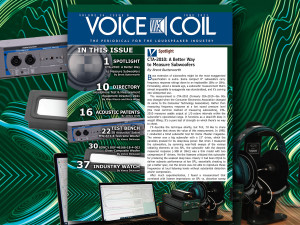 The June 2021 edition of Voice Coil is available for download and already in the mail to print subscribers. Subscribers can go to - www.gotomyvcoil.com - to download this issue.
The June 2021 edition of Voice Coil is available for download and already in the mail to print subscribers. Subscribers can go to - www.gotomyvcoil.com - to download this issue.
Remember, Voice Coil is available in print and download for all registered subscribers, free for industry professionals. To qualify for a free subscription to Voice Coil, or renew your subscription, go to: audioxpress.com/page/Voice-Coil-Subscriber-Services.html
Access to Digital Subscriptions
The pandemic has affected everyone’s lives, including those who provide our delivery service. With a surge in delivery demands and travel restrictions, we realize some of you may be experiencing significant delays in receiving your magazines. So KCK Media opened up its digital subscription platform to all print subscribers for no additional fee. To access it, just login using your subscriber number and post/zip code as displayed on your mailing label.

- on Magazine News
- News
Headphones, Subwoofers, and Cutting-Edge Woofers in Voice Coil June 2021
May 26 2021, 16:35
Voice Coil June 2021 explores the CTA-2010 Standard Method of Measurement for Subwoofers, and follows with a scheduled directory of Headphone Test & Measurement Equipment suppliers and solutions. James Croft reviews an interesting patent exploring a combination design with dual-diaphragm compression drivers, and Vance Dickason characterizes the much-anticipated SB Acoustics Satori MW16TX-8 Textreme Cone 6.5" Woofer, and the very original BDNC BGF-46166-18-4-003 Glass-Composite Diaphragm Woofer. Now available in print and digital.


